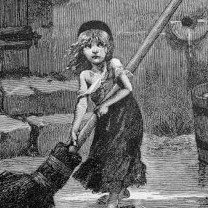The Lark
 It’s funny how “24601” is such a powerful refrain in the musical of Les Misérables, but is barely mentioned in the book*. But there is another nickname** that does keep coming up over and over: The Lark, a name given to little Cosette by the people of Montfermeil.***
It’s funny how “24601” is such a powerful refrain in the musical of Les Misérables, but is barely mentioned in the book*. But there is another nickname** that does keep coming up over and over: The Lark, a name given to little Cosette by the people of Montfermeil.***
She was known locally as l’Alouette, the Lark. The village people, with instinctive symbolism, had thought it a suitable name for the apprehensive, trembling little creature, scarcely more than a bird, who was always first up in that house and out of doors before dawn. But this was a lark that never sang.
Years later the Thénardiers mention it while Marius is listening in, which is how he learns something he can call her. In his despair over being unable to find her, Marius wanders into a field that catches his eye, and then discovers it’s called the Field of the Lark. Of course it must be a sign, so he starts spending all his time there.****
Hugo even compares her to a lark in the narrator’s voice when describing her sense of adventure, and why she doesn’t spook as much as one might expect when Marius starts creeping around the garden.
Cosette was not nervous by nature. There was gipsy blood in her veins, that of a barefooted adventuress. We may recall that she was more like a lark than a dove. She had a wild but courageous heart.
The fact that the book keeps coming back to it makes me wonder why the musical dropped it. It’s a great character hook, especially with the songbird angle. Though given the similar vocal profiles and isolated-damsel-in-the-city roles, maybe they wanted to distance her from Johanna in Sweeny Todd, whose signature song is actually about songbirds.